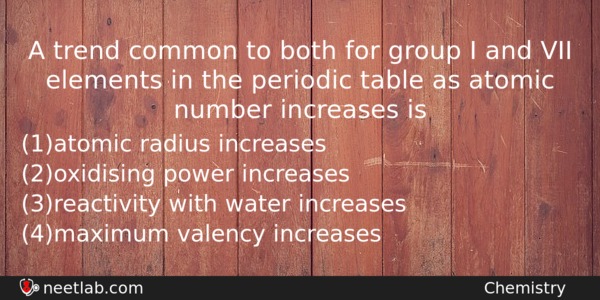| ⇦ | 
| ⇨ |
A trend common to both for group I and VII elements in the periodic table as atomic number increases is
Options
(a) atomic radius increases
(b) oxidising power increases
(c) reactivity with water increases
(d) maximum valency increases
Correct Answer:
Atomic radius increases
Explanation:
Atomic radius increases as no. of shells increases.
Related Questions: - Libermann’s nitroso reaction may be used as a test for
- Wood spirit is known as
- Replacement of Cl of chlorobenzene to give phenol requires drastic conditions.
- The plot of concentration of the reactant vs time for a reaction is a straight
- How many coulombs of electricity are required for the reduction of 1 mol
Question Type: Memory
(964)
Difficulty Level: Easy
(1008)
Topics: Classification of Elements and Periodicity
(94)
Subject: Chemistry
(2512)
Important MCQs Based on Medical Entrance Examinations To Improve Your NEET Score
- Libermann’s nitroso reaction may be used as a test for
- Wood spirit is known as
- Replacement of Cl of chlorobenzene to give phenol requires drastic conditions.
- The plot of concentration of the reactant vs time for a reaction is a straight
- How many coulombs of electricity are required for the reduction of 1 mol
Question Type: Memory (964)
Difficulty Level: Easy (1008)
Topics: Classification of Elements and Periodicity (94)
Subject: Chemistry (2512)
Important MCQs Based on Medical Entrance Examinations To Improve Your NEET Score
18000+ students are using NEETLab to improve their score. What about you?
Solve Previous Year MCQs, Mock Tests, Topicwise Practice Tests, Identify Weak Topics, Formula Flash cards and much more is available in NEETLab Android App to improve your NEET score.
Share this page with your friends

Leave a Reply